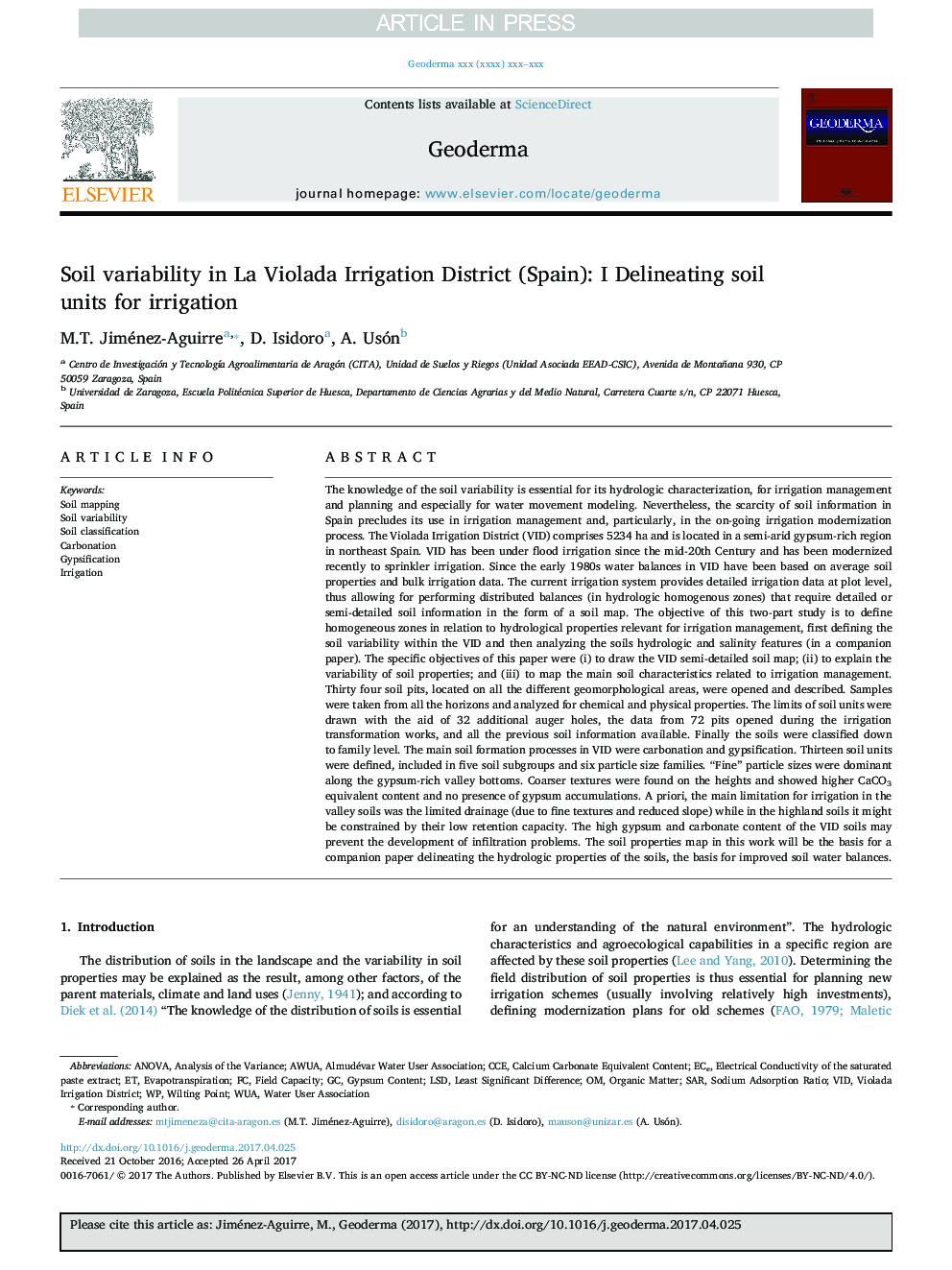| کد مقاله | کد نشریه | سال انتشار | مقاله انگلیسی | نسخه تمام متن |
|---|---|---|---|---|
| 8894389 | 1629406 | 2018 | 13 صفحه PDF | دانلود رایگان |
عنوان انگلیسی مقاله ISI
Soil variability in La Violada Irrigation District (Spain): I Delineating soil units for irrigation
دانلود مقاله + سفارش ترجمه
دانلود مقاله ISI انگلیسی
رایگان برای ایرانیان
کلمات کلیدی
SARVIDWUAGypsum contentCCELSDECe - ECAIrrigation - آبیاریWater user association - انجمن کاربر آبEvapotranspiration - تبخیر و تعرقanalysis of the variance - تجزیه و تحلیل واریانسANOVA - تحلیل واریانس Analysis of varianceSoil variability - تنوع خاکleast significant difference - حداقل تفاوت قابل توجهیSoil classification - طبقه بندی خاکField capacity - ظرفیت میدانorganic matter - ماده آلیsodium adsorption ratio - نسبت جذب سدیمSoil mapping - نقشه برداری خاکWilting point - نکته تکان دهندهCarbonation - کربناته
موضوعات مرتبط
مهندسی و علوم پایه
علوم زمین و سیارات
فرآیندهای سطح زمین
پیش نمایش صفحه اول مقاله

چکیده انگلیسی
The knowledge of the soil variability is essential for its hydrologic characterization, for irrigation management and planning and especially for water movement modeling. Nevertheless, the scarcity of soil information in Spain precludes its use in irrigation management and, particularly, in the on-going irrigation modernization process. The Violada Irrigation District (VID) comprises 5234Â ha and is located in a semi-arid gypsum-rich region in northeast Spain. VID has been under flood irrigation since the mid-20th Century and has been modernized recently to sprinkler irrigation. Since the early 1980s water balances in VID have been based on average soil properties and bulk irrigation data. The current irrigation system provides detailed irrigation data at plot level, thus allowing for performing distributed balances (in hydrologic homogenous zones) that require detailed or semi-detailed soil information in the form of a soil map. The objective of this two-part study is to define homogeneous zones in relation to hydrological properties relevant for irrigation management, first defining the soil variability within the VID and then analyzing the soils hydrologic and salinity features (in a companion paper). The specific objectives of this paper were (i) to draw the VID semi-detailed soil map; (ii) to explain the variability of soil properties; and (iii) to map the main soil characteristics related to irrigation management. Thirty four soil pits, located on all the different geomorphological areas, were opened and described. Samples were taken from all the horizons and analyzed for chemical and physical properties. The limits of soil units were drawn with the aid of 32 additional auger holes, the data from 72 pits opened during the irrigation transformation works, and all the previous soil information available. Finally the soils were classified down to family level. The main soil formation processes in VID were carbonation and gypsification. Thirteen soil units were defined, included in five soil subgroups and six particle size families. “Fine” particle sizes were dominant along the gypsum-rich valley bottoms. Coarser textures were found on the heights and showed higher CaCO3 equivalent content and no presence of gypsum accumulations. A priori, the main limitation for irrigation in the valley soils was the limited drainage (due to fine textures and reduced slope) while in the highland soils it might be constrained by their low retention capacity. The high gypsum and carbonate content of the VID soils may prevent the development of infiltration problems. The soil properties map in this work will be the basis for a companion paper delineating the hydrologic properties of the soils, the basis for improved soil water balances.
ناشر
Database: Elsevier - ScienceDirect (ساینس دایرکت)
Journal: Geoderma - Volume 311, 1 February 2018, Pages 78-90
Journal: Geoderma - Volume 311, 1 February 2018, Pages 78-90
نویسندگان
Jiménez-Aguirre M.T., Isidoro D., Usón A.,